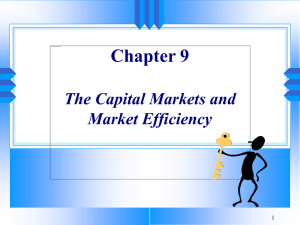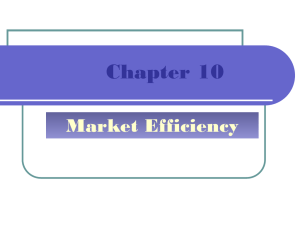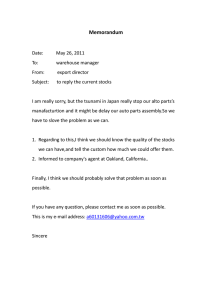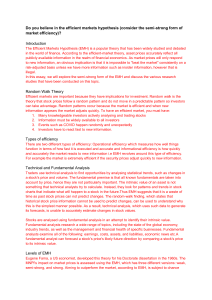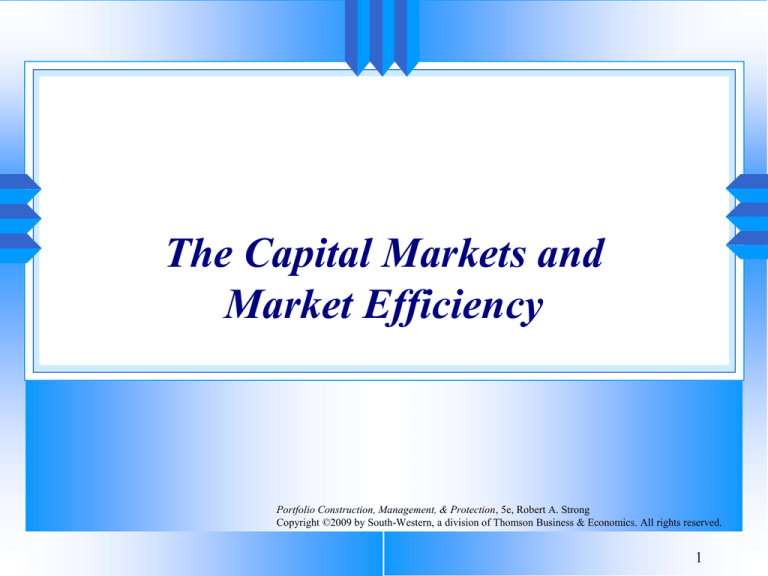
The Capital Markets and
Market Efficiency
Portfolio Construction, Management, & Protection, 5e, Robert A. Strong
Copyright ©2009 by South-Western, a division of Thomson Business & Economics. All rights reserved.
1
No matter how many winners you’ve got, if you
either leverage too much or do anything that gives
you the chance of having a zero in there, it’ll all
turn into pumpkins and mice.
Warren Buffett
2
Introduction
Capital market theory springs from the notion
that:
• People like return
• People do not like risk
• Dispersion around expected return is a
reasonable measure of risk
3
Role of the Capital Markets
Capital
markets trade securities with lives
of more than one year
Examples
•
•
•
•
of capital markets
New York Stock Exchange (NYSE)
American Stock Exchange (AMEX)
Chicago Board of Trade
Chicago Board Options Exchange (CBOE)
4
Economic Function
The
economic function of capital markets
facilitates the transfer of money from savers
to borrowers
• e.g., mortgages, Treasury bonds, corporate
stocks and bonds
5
Continuous Pricing Function
The
continuous pricing function of capital
markets means prices are available moment
by moment
• Continuous prices are an advantage to investors
• Investors are less confident in their ability to
get a quick quotation for securities that do not
trade often
6
Fair Price Function
The
fair price function of capital markets
means that an investor can trust the
financial system
• The function removes the fear of buying or
selling at an unreasonable price
• The more participants and the more formal the
marketplace, the greater the likelihood that the
buyer is getting a fair price
7
Efficient Market Hypothesis
Definition
Types
of Efficiency
Weak Form
Semi-Strong Form
Strong Form
Semi-Efficient Market Hypothesis
Security Prices and Random Walks
8
Definition
The
efficient market hypothesis (EMH) is
the theory supporting the notion that market
prices are in fact fair
• In an efficient market prices quickly and
accurately adjust to reflect new information
• The EMH is perhaps the most important
paradigm in finance
9
Types of Efficiency
Operational
efficiency measures how well
things function in terms of speed of
execution and accuracy
• It is a function of the number of orders that are
lost or filled incorrectly
• It is a function of the elapsed time between the
receipt of an order and its execution
10
Types of Efficiency (cont’d)
Informational
efficiency is a measure of
how quickly and accurately the market
reacts to new information
• It relates directly to the EMH
• The market is informationally very efficient
– Security prices adjust rapidly and accurately to new
information
– The market is still not completely efficient
11
Weak Form
The
weak form of the EMH states that it is
impossible to predict future stock prices by
analyzing prices from the past
• The current price is a fair one that considers
any information contained in the past price data
• Charting techniques are of no use in predicting
stock prices
12
Definition (cont’d)
Example
Which stock is a better buy?
Stock A
Current Stock Price
Stock B
13
Definition (cont’d)
Example (cont’d)
Solution: According to the weak form of the EMH,
neither stock is a better buy, since the current price
already reflects all past information.
14
Charting
People
who study charts are technical
analysts or chartists
• Chartists look for patterns in a sequence of
stock prices
• Many chartists have a behavioral element
15
Runs Test
A
runs test is a nonparametric statistical
technique to test the likelihood that a series
of price movements occurred by chance
• A run is an uninterrupted sequence of the same
observation
• A runs test calculates the number of ways an
observed number of runs could occur given the
relative number of different observations and
the probability of this number
16
Conducting A Runs Test
Z
Rx
where R number of runs
2n1n2
x
1
n1 n2
2n1n2 (2n1n2 n1 n2 )
n1 n2
2
(n1 n2 1)
n1 , n2 number of observations in each category
Z standard normal variable
17
Semi-Strong Form
The
semi-strong form of the EMH states
that security prices fully reflect all publicly
available information
• e.g., past stock prices, economic reports,
brokerage firm recommendations, investment
advisory letters, etc.
18
Semi-Strong Form (cont’d)
Academic
research supports the semi-strong
form of the EMH by investigating various
corporate announcements, such as:
• Stock splits
• Cash dividends
• Stock dividends
This
means investors are seldom going to
beat the market by analyzing public news
19
Semi-Strong Form (cont’d)
Burton
Malkiel points out that two-thirds of
professionally managed portfolios are
consistently beaten by a low-cost index
fund
• Suggests that securities are accurately priced
and that in the long run returns will be
consistent with the level of systematic risk
taken
20
Strong Form
The
strong form of the EMH states that
security prices fully reflect all relevant
public and private information
This means even corporate insiders cannot
make abnormal profits by using inside
information about their company
• Inside information is information not available
to the general public
21
Semi-Efficient
Market Hypothesis
The
semi-efficient market hypothesis
(SEMH) states that the market prices some
stocks more efficiently than others
• Less well-known companies are less efficiently
priced
• The market may be tiered
• A neglected firm effect may exist
22
Security Prices and
Random Walks
The
unexpected portion of news follows a
random walk
• News arrives randomly and security prices
adjust to the arrival of the news
– We cannot forecast specifics of the news very
accurately
23
Anomalies
A
financial anomaly refers to unexplained
results that deviate from those expected
under finance theory
• Especially those related to the efficient market
hypothesis
• Many examples of financial anomalies are
reported to exist
24
Low PE Effect
Stocks
with low PE ratios may provide
higher returns than stocks with higher PEs
Supported
by several academic studies
Conflicts
directly with the CAPM, since
study returns were risk-adjusted (Basu)
25
Low-Priced Stocks
Stocks
with a “low” stock price earn higher
returns than stocks with a “high” stock price
There
is an optimum trading range
26
Small-Firm Effect
Investing
in firms with low market
capitalization will provide superior riskadjusted returns
Supported
by academic studies
Implies
that portfolio managers should give
small firms particular attention
27
Neglected-Firm Effect
Security
analysts do not pay as much
attention to firms that are unlikely portfolio
candidates
Implies
that neglected firms may offer
superior risk-adjusted returns
28
Market Overreaction
The
tendency for the market to overreact to
extreme news
• Investors may be able to predict systematic
price reversals
Results
because people often rely too
heavily on recent data at the expense of the
more extensive set of prior data
29
January Effect
Stock
returns are inexplicably high in
January
Small
firms do better than large firms early
in the year
Especially
pronounced for the first five
trading days in January
30
January Effect (cont’d)
Possible
explanations:
• Tax-loss trading late in December (Branch)
• The risk of small stocks is higher early in the
year (Rogalski and Tinic)
31
Types of Firms in January
Average
January
return
S&P 500
Companies
Highly Researched
Moderately
Researched
Neglected
Non-S&P 500
Companies
Neglected
Average January return Average January
minus average monthly return after adjusting
return in rest of year
for systematic risk
2.48%
4.95%
1.63%
4.19%
-1.44%
1.69%
7.62%
6.87%
5.03%
11.32%
10.72%
7.71%
Source: Avner Arbel, “Generic Stocks: The Key to Market Anomalies,” Journal of Portfolio Management, Summer 1985, 4–13.
32
Day-of-the-Week Effect
Mondays
are historically bad days for the
stock market
Wednesday
and Fridays are consistently
good
Tuesdays
and Thursdays are a mixed bag
33
Day-of-the-Week
Effect (cont’d)
Should
not occur in an efficient market
• Once a profitable trading opportunity is
identified, it should disappear
The
day-of-the-week effect continues to
persist
34
Turn-of-the-Calendar Effect
The
bulk of the return comes from the last
trading day of the month and the first few
days of the following month
For
the rest of the month, the ups and
downs approximately cancel out
35
Persistence of
Technical Analysis
Technical
analysis refers to any technique
in which past security prices or other
publicly available information are employed
to predict future prices
Studies show the markets are efficient in the
weak form
Literature based on technical techniques
continues to appear but should be useless
36
Chaos Theory
Chaos
theory refers to instances in which
apparently random behavior is systematic or
even deterministic
Econophysics refers to the application of
physics principles in the analysis of stock
market behavior
• e.g., an investment strategy based on studies of
turbulence in wind tunnels
37

